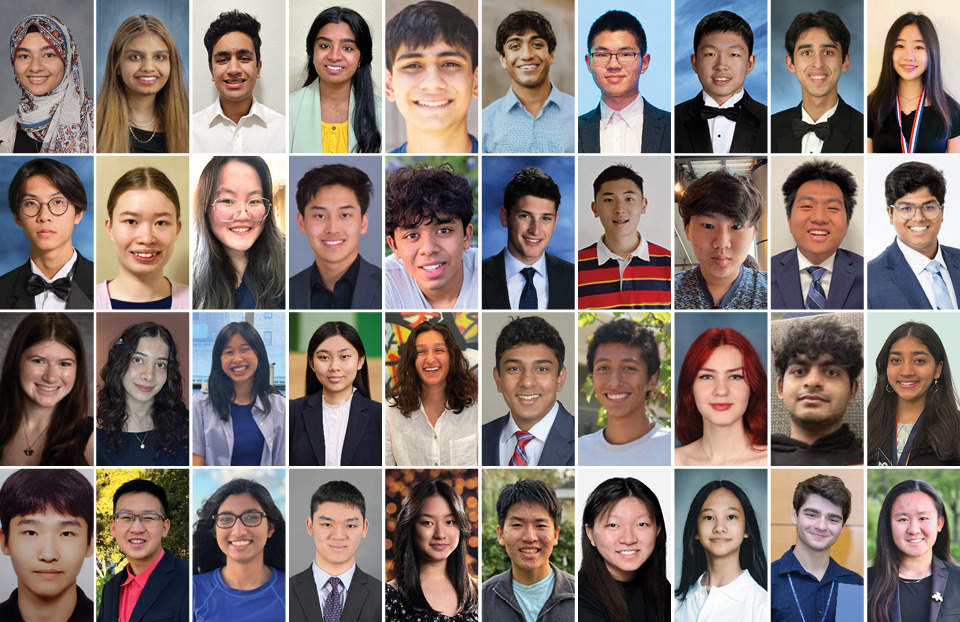Regeneron Science Talent Search
2024 Finalists
The Regeneron Science Talent Search 2024 finalists represent 36 schools across 19 states. They are competing for more than $1.8 million, with a top prize of $250,000. Finalists were selected from 300 scholars and 2,162 entrants, the largest pool of applicants since the 1960s, based on the originality and creativity of their scientific research as well as their achievement and leadership both inside and outside of the classroom.
- Meet the Finalists in DC!
- View the Finalist Book
- The Society also congratulates the Top 300 Scholars, announced on January 10
- Sign up to receive updates about Regeneron STS
Regeneron Science Talent Search 2024 Finalists
Maryam Abdel-Azim
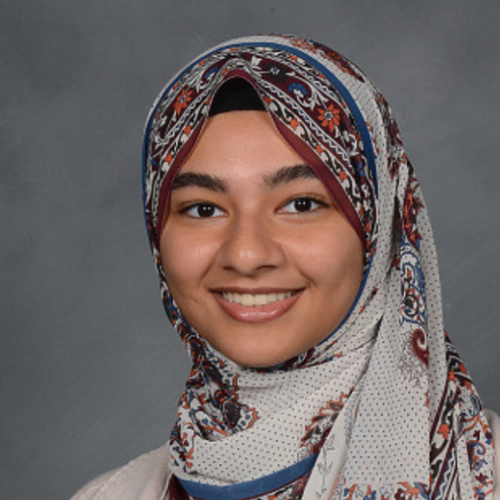
School: Central Bucks High School East, Doylestown, PA
Project Title: Targeting Signaling Molecules of P. aeruginosa by Using Mucin as an Anti-Quorum Sensing Drug: A Novel Design To Evaluate Efficacy in the Context of Multidrug Resistance
Maryam Abdel-Azim, 17, of Doylestown , investigated ways to disrupt quorum sensing (QS), one method cells use to communicate, in the harmful bacteria Pseudomonas aeruginosa, for her Regeneron Science Talent Search cellular and molecular biology project. Quorum sensing is one way bacterial colonies send signals to nearby cells to collect and share information. In this case, QS detects when levels are high enough to form biofilms (similar to plaque that leads to tartar). Biofilms facilitate the harmful effects of disease and protect the bacteria from antibiotics, creating drug resistance. Maryam has studied this process for years, starting with experiments in her basement laboratory. Then she connected with a research laboratory group with whom she developed experiments to explore compounds that prevent QS. Maryam believes, and her research showed, that by manipulating compounds found in mucus, QS can be decreased or prevented, opening the door to developing drug alternatives to antibiotics. Maryam is a varsity tennis player and student government rep at Central Bucks High School East.Her parents are Gamal Abdel-Azim and Sahar Sherif. She wants to one day lead interdisciplinary teams toward eradicating antibiotic resistance.
Saraswathy Amjith
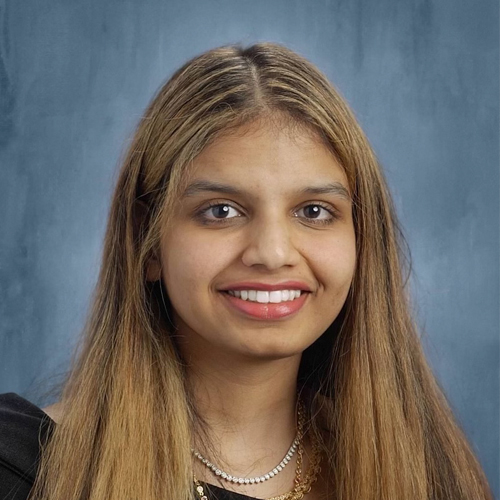
School: Tesla STEM High School, Redmond, WA
Project Title: A Novel Integrated Machine Learning Approach Utilizing Radar and Satellite Imagery for Selective Logging Remote Sensing Detection and Accompanying AI-Logging Map-Generating Webtool
Saraswathy Amjith, 18, of Redmond, developed a way to more accurately identify illegal logging for her Regeneron Science Talent Search environmental science project. Developing nations struggle to stop illegal deforestation. To detect it in real time, some stakeholders use satellite optical imagery, but savvy criminals have switched from clear cutting to removing only the larger, more valuable trees, which makes the logging more difficult to detect. Additionally, optical imagery requires cloud-free conditions, which is often not the case in the humid tropics. In her project, Saraswathy found that she could help compensate for cloudy weather by combining satellite optical and radar datasets, since radar imagery is not affected by clouds. She then tested various machine learning approaches and determined which was most accurate for this application. The daughter of Lakshmi Unni and Amjith Veettil, Saraswathy attends Tesla STEM High School, where she helps lead a math honors society. She is the founder and president of a nonprofit that offers free teaching and tutoring to more than 200 underserved students and holds STEM camps, workshops, hackathons, and STEM speaker events with more than 2,000 participants.
Aarav Arora
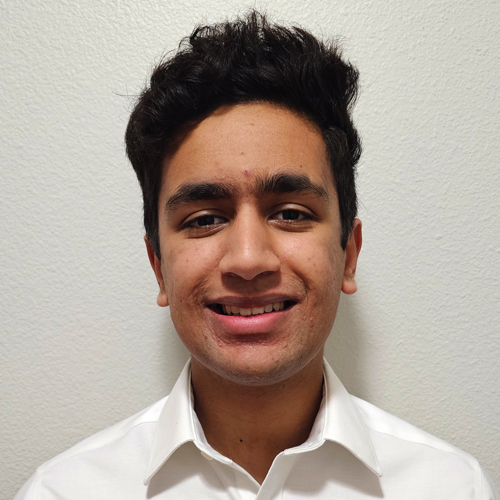
School: Del Norte High School, San Diego, CA
Project Title: A Mechanistic Basis for the Analysis of SARS-CoV-2 Omicron Variant Severity
Aarav Arora, 18, of San Diego, developed a different approach to use patient symptom data and a mechanistic basis to analyze the severity of the Omicron variant of COVID-19 for his Regeneron Science Talent Search genomics project. Each time the virus mutates, existing vaccines may become less effective. Aarav used statistical methods to identify which mutated variants cause the most severe symptoms. He then determined the destabilizing effects that each mutation had on a variant’s protein structure. Aarav also determined whether each mutation appeared alone or worked in combination with a second mutation. He believes his research has identified areas of interest for the development of future targeted vaccines. An avid debater, Aarav is president of his speech and debate club at Del Norte High School, where he also created a debate elective class. He also developed a machine-learning approach to the early detection of voice-box cancer, about which he published a paper in European Archives of Laryngology as first author. While he enjoys writing articles, Aarav’s life goal is to help scientists and patients in ways that have a greater impact than journal submissions. His parents are Vimal and Vineeta Arora.
Aditi Avinash
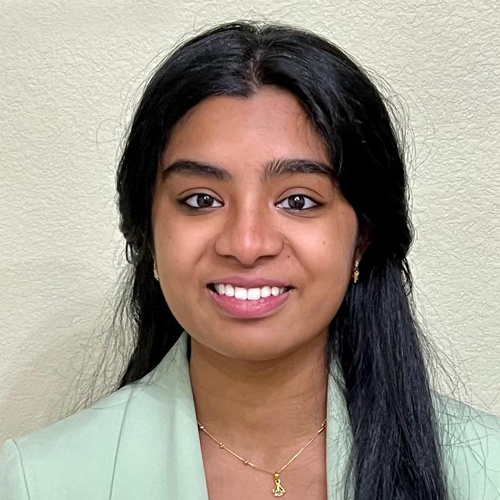
School: Rock Canyon High School, Highlands Ranch, CO
Project Title: Model Validation and Preclinical Testing of Digestive Enzymes for Gluten Breakdown: A Move To Cure Gluten Intolerance and Celiac Disease
Aditi Avinash, 17, of Castle Pines, found a mixture of three enzymes that she believes could one day be used to reduce the effects of gluten intolerance for her Regeneron Science Talent Search medicine and health project. Aditi tested three enzymes derived from fruits that had previously been shown to break down gluten proteins in experimental settings mimicking the acidic stomach environment. Her work indicated that combining the enzymes was more effective in breaking down gluten and reducing the immune response of T-cells than administering the enzymes sequentially. Aditi envisions creating a pill that would prevent the discomfort caused by celiac disease and gluten intolerance, allowing people with these conditions to eat wheat products. Aditi attends Rock Canyon High School in Highlands Ranch, where she is president of the Science National Honors Society and Health Occupations Students of America. She’s also a classically trained Indian Kuchipudi dancer and Carnatic singer and can identify any Taylor Swift song within five seconds. The daughter of Padma Avinash and Senthil Avinash, Aditi wants to earn her MD and PhD to combine “clinical compassion” with her “love of research.”
Harshil Avlani
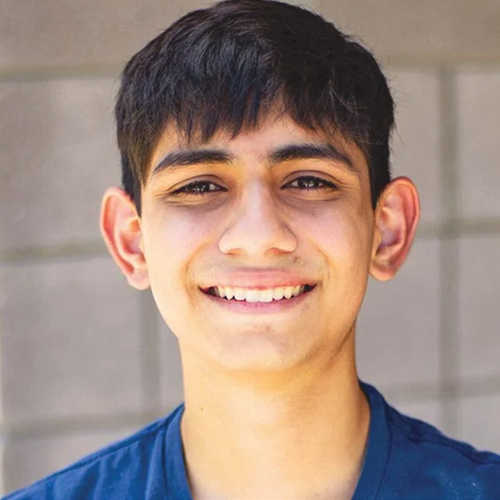
School: BASIS Chandler, Chandler, AZ
Project Title: Analyzing the Effect of Mid-Circuit Measurement (MCM) on Spectator Qubits
Harshil Avlani, 17, of Chandler, researched a way to describe quantum computing errors by observing physical qubits (the basic units of information) as they are exposed to the quantum mid-circuit measurement (MCM) gate at various distances for his Regeneron Science Talent Search computer science project. Seeking a better understanding of the MCM gate, Harshil created pairs of quantum circuits (one included an MCM gate and one did not) and examined the effect of the microwave that the MCM sends to the measured qubit during calculations. After he tested them more than 300 million times on various quantum computers, results suggested that the MCM gate causes a significant increase in “spectator qubit” errors if the measured gate and spectator qubits were close together. Harshil also found that some current quantum simulators do not account for the significant errors that he identified. The son of Chetan and Neelima Avlani, Harshil attends BASIS Chandler, where he helped lead the debate team and, as a head of the Red Cross club, managed three blood drives. He is also an accomplished pianist. He hopes one day to earn a doctorate in physics so he can help with “molding even more STEM enthusiasts.”
Arav Bhargava
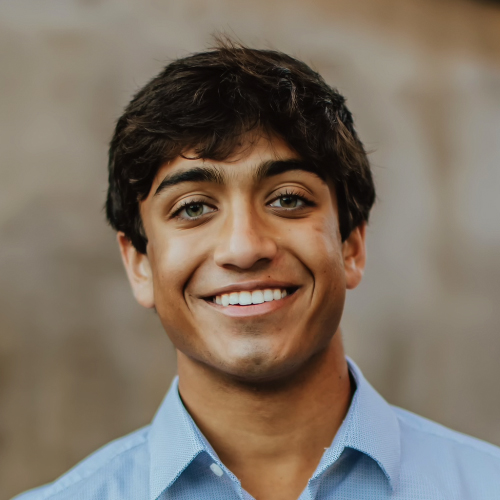
School: The Potomac School, McLean, VA
Project Title: Low-Cost, 3D-Printed, Universal-Fit, Transradial Socket for Amputees in Developing Countries
Arav Bhargava, 18, of McLean, created a low-cost universal socket, a segment of a prosthetic arm, for his Regeneron Science Talent Search engineering project. Although it’s only a prototype, Arav’s socket approaches standard weight-bearing requirements and can be made for less than $40. Nearly 40 million people in developing nations need prosthetics, which currently require custom fittings and can cost thousands of dollars, making them inaccessible to most people. Arav developed his 3D-printed socket with circumference and length-expansion mechanisms that can easily be adjusted to fit a wide range of residual limbs for individuals who have undergone an arm amputation. Equally important, two volunteers tested the prototype device and they both said it was more comfortable than their current prosthetic sockets. Arav, the son of Sameer and Nimisha Bhargava, is the team captain of the robotics club at The Potomac School. Arav is also a varsity swimmer and captain of his swim team, and volunteers with Arlington County Adaptive Aquatics, teaching children with disabilities to swim, which is how he was inspired to conduct this research. Arav also developed a seven-episode podcast called “The Prosthetic Experience.”
Alan Bu
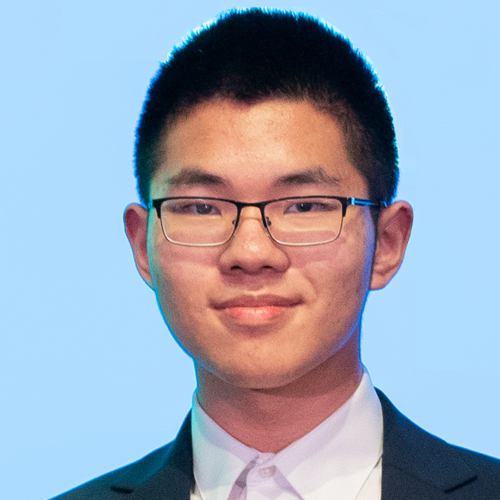
School: Phillips Exeter Academy, Exeter, NH
Project Title: On the Maximum Number of Spanning Trees in a Planar Graph With a Fixed Number of Edges: A Linear-Algebraic Connection
Alan Bu, 17, of Glenmont, New York, made connections between graph theory and linear algebra for his Regeneron Science Talent Search mathematics project. Alan’s project provides precise limits on the number of spanning trees a planar graph, a graph in which no edges cross each other, can have. A spanning tree is a minimal selection of edges that connects all the objects in a graph. Mathematical graphs are used to represent and study objects and how they relate to each other, such as how molecules form lattices in solids. Knowing the number of spanning trees of a graph gives important insights into its structure, which can then be used in applications. Previous work had estimated this number, but Alan made these estimates much more precise. His key insight was to connect the number of spanning trees to a linear algebra problem, a different field of math concerned with matrices. At Phillips Exeter Academy in Exeter, New Hampshire, Alan is co-head of the school’s chess team, the science bowl club, and volunteered as a peer tutor. As director of math club competitions, he has connected with hundreds of middle school students from across the U.S. and China. Alan is the son of Ye Zhong and Huiming Bu.
David Lu Cao
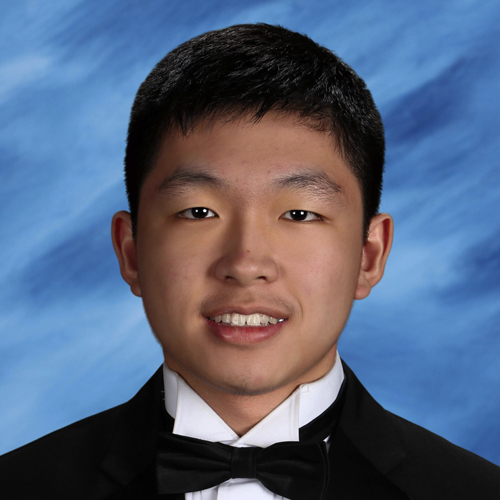
School: Thomas Jefferson High School for Science and Technology, Alexandria, VA
Project Title: The Implications of ‘Oumuamua on Panspermia
David Lu Cao, 18, of Vienna, investigated the origin of life on Earth for his Regeneron Science Talent Search space science project. Inspired by the 2017 discovery of ‘Oumuamua, the first confirmed interstellar object ever observed in our solar system, David analyzed the possibility that microorganisms might have arrived here from elsewhere in the universe billions of years ago by hitching a ride inside comets or asteroids. He used the properties of ‘Oumuamua to estimate the likely mass and number of such interstellar objects and then calculated how large such objects would have to be to adequately shelter the microbes from supernova-derived gamma rays. Assuming optimal conditions, he calculated a probability of this combination as 10% at best. He then tried to consider less quantifiable factors, such as how likely it was these objects might harbor organisms and whether their appearance could have led to the establishment of life on Earth, likely lowering the probability by orders of magnitude. The son of Lin Cao and Junrong Lu, David leads the computational physics club and co-captains the chess club at Thomas Jefferson High School for Science and Technology in Alexandria, where he is also on the varsity track and field team.
Arnav N. Chakravarthy
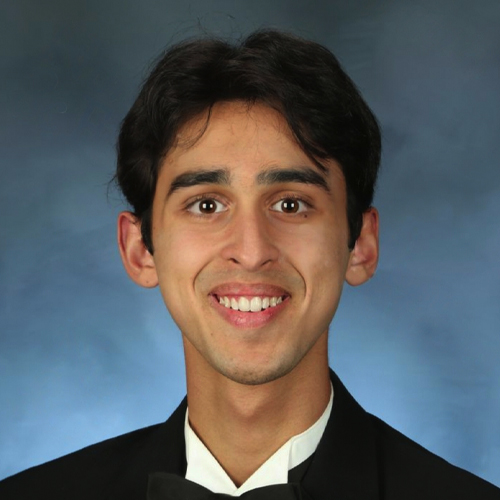
School: Homestead High School, Cupertino, CA
Project Title: Leveraging Mitochondrial DNA Mutations for Macrophage Lineage Tracing in Primary Human Tissues
Arnav N. Chakravarthy, 18, of Sunnyvale, investigated how macrophage cells replenish in aging humans for his Regeneron Science Talent Search cellular and molecular biology project. A macrophage is a type of immune system cell that’s important for the body’s inflammatory response and cleanup. It is believed these cells originate during fetal development, but recent studies suggest that macrophages may also develop from bone marrow as we age. Arnav hypothesized that a type of brain macrophage called microglia may also replenish in this manner. To test this theory, Arnav used a genomics tool to trace the origins of brain and liver samples alongside bone marrow samples from the same donors and compared the cell’s lineage and unique mutations. His findings show promise for the regenerative possibilities of macrophage cells, including those that affect age-related diseases like Alzheimer’s. Arnav serves as state secretary of the California Future Business Leaders of America and is co-founder and CEO of an A.I.-powered startup that streamlines research and workflows for scientists. The son of Leena Vakil and Venkatesh Chakravarthy, he has also captained the junior varsity tennis team at Homestead High School in Cupertino.
Sophie Chen
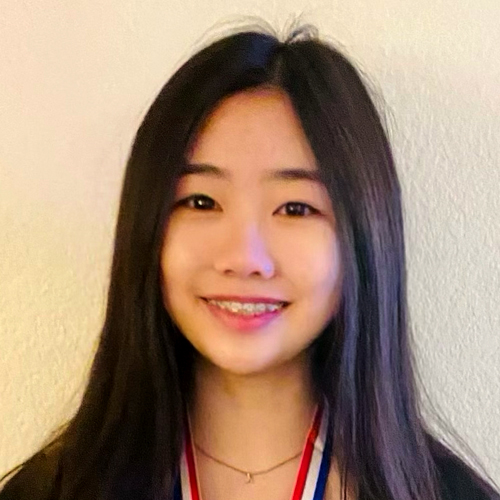
School: Caddo Parish Magnet High School, Shreveport, LA
Project Title: Intraoperative Histological Analysis of Squamous Cell Carcinoma Tumor Margins Using a Convolutional Neural Network
Sophie Chen, 17, of Shreveport, developed a convolutional neural network (CNN) machine learning model to review microscopic images of tissue during removal of squamous cell carcinoma (SCC) for her Regeneron Science Talent Search computational biology and bioinformatics project. Currently, analyzing tissue during removal of SCC can be time-consuming and is prone to error. Sophie’s CNN model was trained to look at slides of removed tissues and recognize the basic differences between tumor, inflammation, and benign areas. Her model proved to be robust, fast, and able to accurately identify suspicious tissues from images. Sophie believes it to be an important tool to assist surgeons in determining whether the tumor is fully removed. Sophie attends Caddo Parish Magnet High School where she participates in mock trial, plays violin in the school orchestra, and runs a mental health club. She also co-founded a nonprofit that provides access to computer science education to young girls in underserved communities. The daughter of Xinqian Jiang and Shoujun Chen, Sophie wants to pursue a Ph.D. in computational biology to harness the power of A.I. to drive real change.
Thomas Cong
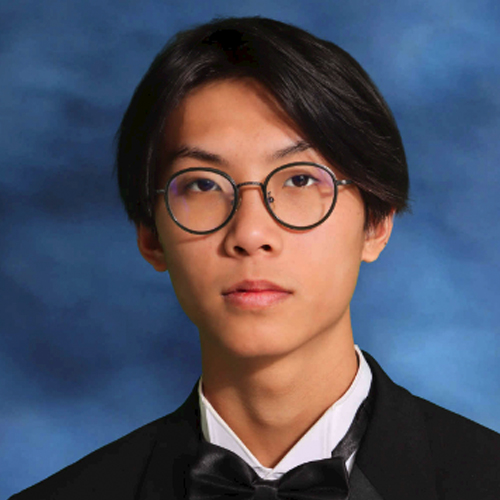
School: Ossining High School, Ossining, NY
Project Title: Overlooked Covariates in Metabolite Abundance Levels: Systematically Quantifying the Information Overlap Between Gene Expression and Metabolism Across Multiple Cancer Types
Thomas Yu-Tong Cong, 17, of Ossining, researched the rapid growth of certain types of cancers and wondered whether information needed to control metabolism is primarily conveyed by expression of genes for his Regeneron Science Talent Search computational biology and bioinformatics project. For drug developers, metabolic pathways have traditionally been a prime target, so Thomas aimed to evaluate that premise and found it questionable. He applied a statistical framework he developed to large cancer metabolism datasets, and he was able to systematically isolate the intersection between information transcribed from genes and the metabolic machinery those genes are responsible for. He concluded that factors like the cancer’s tissue of origin, its surrounding environment in the body, and how many cancer cells there are in a mass, strongly influence metabolic signatures. This suggests that a more complex landscape of metabolic variation exists. The son of Guojing Cong and Min Qu, Thomas is a Yale Book Award winner. He attends Ossining High School where he heads the cross-country team and swims competitively in the 200m medley relay, the 100m breaststroke, and the 200m and 400m freestyle relays.
Sophie D'Halleweyn
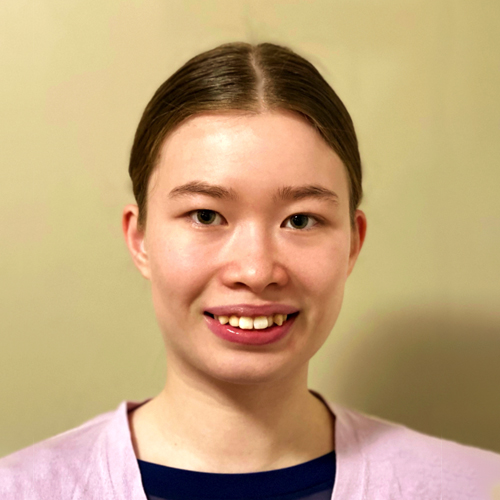
School: Bronx High School of Science, Bronx, NY
Project Title: Alleviating the Energy Crisis: A Novel Multi-Task Machine Learning Algorithm for Designing Efficient Nanocatalysts To Reduce Industrial Energy Impact
Sophie D’Halleweyn, 17, of New York, developed a machine-learning algorithm to optimize the design and production of catalysts for her Regeneron Science Talent Search materials science project. The algorithm uses data from X-ray spectral analysis to provide detailed information on the structure of nanometer-sized catalyst particles. Sophie demonstrated the effectiveness of the approach by applying it to palladium-based nanoparticles, which are used in batteries, fuel cells, the production of microchips, and other green energy applications. She was able to obtain the fraction of hydrogen atoms in the nanoparticles, their interatomic distances, and the coordination numbers; these are factors that can be modified to improve catalytic performance. Sophie believes her algorithm will allow manufacturers to make real-time adjustments to the manufacturing process and thereby help the U.S. become less dependent on other nations for such catalysts. Sophie, the daughter of Peiyu Hsu and Rafael D’Halleweyn, is on the math team at the Bronx High School of Science. She also volunteers as an assistant educator at the New York Botanical Garden, performs classical ballet, and is a published writer of poetry and prose.
Sophie Gao
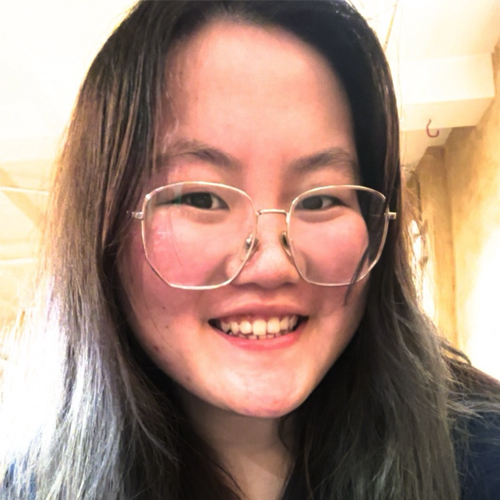
School: Hunter College High School, New York, NY
Project Title: Uncovering Mechanisms of Action and Resistance for KRAS G12D Inhibitor MRTX1133 Using Drosophila melanogaster Models
Sophie Gao, 17, of New York, studied a protein blocker’s ability to combat a tumor-causing cell protein that exists in some of the deadliest cancers for her Regeneron Science Talent Search medicine and health project. Long thought to be “undruggable,” the KRAS G12D protein is found in 4.2% of all cancer cases in a major cancer database, including one of the most deadly, pancreatic cancer. Modeling for the KRAS protein in fruit flies, whose cell communication methods are similar to humans, Sophie found that higher dosages of the protein blocker MRTX1133 led to higher survival. Considering that drug resistance often develops when used alone, she also found the potential to mix MRTX1133 with other drugs. Sophie believes this is the first time fruit flies have been used as a model for this type of therapy, and that this may be a cost effective way to possibly identify new treatments for KRAS protein related cancers. Sophie attends Hunter College High School where she is editor-in-chief of the school newspaper and co-runs a program teaching science to elementary students. The daughter of Qing Liu and Dingcheng Gao, Sophie wants to go into medicine and write about science for general audiences.
William Gao
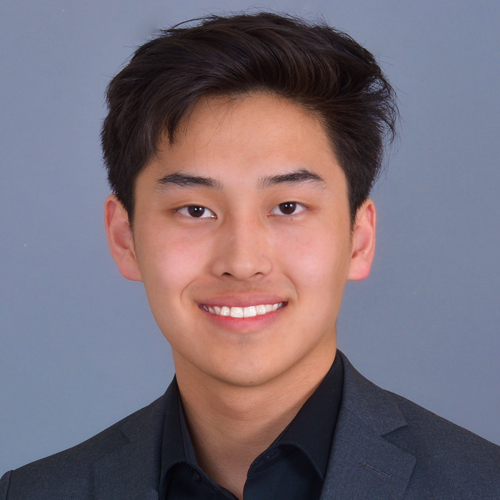
School: Centennial High School, Ellicott City, MD
Project Title: Designing a Federated Learning-Driven Collaborative Diagnostic System for Metastatic Breast Cancer: Reducing Long Diagnosis Delays and Improving Patient Survival Outcomes in Developing Countries
William Gao, 18, of Ellicott City, created a diagnostic image analysis tool that reduces delays in the diagnosis of metastatic breast cancer caused by the lack of highly skilled pathologists in underserved regions for his Regeneron Science Talent Search bioengineering project. His research, part of which he published as first author in Cancer Informatics, uses federated learning, a kind of machine learning, to detect breast cancer from patient images without threatening patient privacy since it does not require the transfer of patient data between institutions. His system includes safeguards for patient privacy and can even be deployed using a smartphone to facilitate its use in regions where medical centers are geographically far apart. Initial tests showed his tool outperformed traditionally trained models when identifying areas of metastatic breast cancer. William founded the science research club at Centennial High School where he is also editor-in-chief of the science journal. He is also a nationally ranked fencer and volunteers as an assistant youth coach. The son of Zhong Gao and Weiping Shi, William wants to pursue an academic career to bring scientific advancements in A.I. and medical tech to communities in need.
Sarang Goel
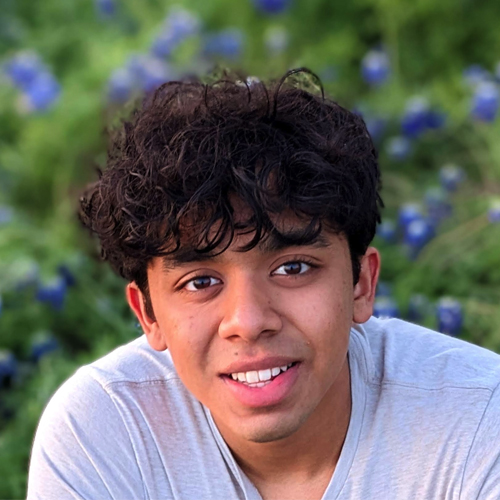
School: Texas Academy of Mathematics and Science, Denton, TX
Project Title: IVY – Intelligent Vision System for the Visually Impaired: Innovative Low-Cost, AI-Based Eyeglasses To Help the Visually Impaired Overcome Mobility Limitations Through Navigational Assistance and Object Avoidance Algorithms and an Intuitive Vibration and Audio Guidance System
Sarang Goel, 18, of Irving, developed a vision technology for people with failing eyesight to increase their mobility for his Regeneron Science Talent Search engineering project. Inspired by the difficulties faced by a diabetic family friend with poor eyesight, Sarang spent over two years working at home researching, developing, and testing his Intelligent Vision System (IVY) which consists of: the eyeglasses device (with customized computer processor), automated mapping and navigation algorithms, object detection and avoidance software, and an audio system and smartphone app. His finished IVY system met all his engineering goals, cost him less than $300 to make, and he is fine-tuning his eyeglasses to make them more comfortable and durable. Sarang was awarded a patent in 2022 for an invention to improve cabin air in vehicles. As first author, he has published a paper in the Journal of Clinical Medicine. The son of Rakesh and Seema Goel, Sarang attends Texas Academy of Mathematics and Science in Denton, where he coordinates research competition activities for students. He hopes one day to earn a doctorate in computer science and develop more wearable devices for people with mobility limitations.
Jacob Tyler Gross
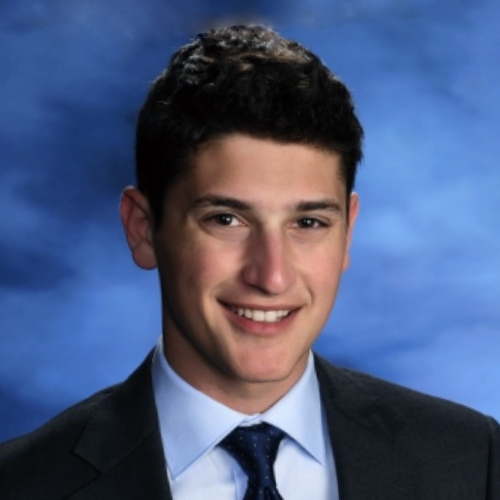
School: Roslyn High School, Roslyn Heights, NY
Project Title: Investigating Synergistic Interactions Among SARS-CoV-2 Neutralizing Antibodies
Jacob Tyler Gross, 17, of Roslyn, investigated whether synergistic interactions may increase the power of current antibody treatments for COVID-19 infection for his Regeneron Science Talent Search medicine and health project. COVID-19, which has caused millions of deaths, mutates rapidly as it spreads. These mutations mean antibodies used to treat COVID-19-related illness may be less effective against certain COVID-19 variants. Jacob sought to learn whether combining antibodies could increase treatment power. He found that an antibody called S309 works better in combatting an Omicron subvariant when combined with another antibody class. This research may shine a light on the design of COVID antibody cocktails and inspire further research into the stronger effect of combined interactions of antibodies, including research to confirm that these in-vitro results. Jacob attends Roslyn High School in Roslyn Heights, where he edits the school psychological research journal and plays viola. He also founded a nonprofit math tutoring business whose proceeds benefit a healthcare network. The son of Danielle and Brian Gross, Jacob is passionate about doing research and plans to obtain his M.D.-Ph.D.
Luke Huang
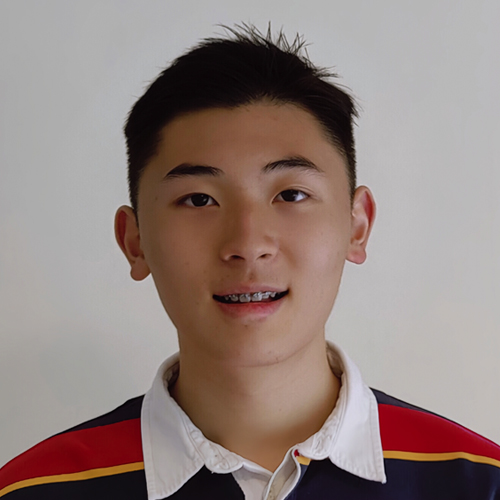
School: New Canaan High School, New Canaan, CT
Project Title: Binary Cellular Analysis: Understanding the Link Between Aging and Mortality Risk
Luke Huang, 17, of New Canaan, developed a mathematical model that assesses how cellular damage increasingly elevates the risk of death as people age for his Regeneron Science Talent Search computational biology and bioinformatics project. Our probability of death doubles every eight years, and age-related diseases like heart disease account for two-thirds of all deaths worldwide – but the connection between aging and this increased risk is poorly understood. To better grasp it, Luke combined a numerical simulation with a mathematical model that shows how cell damage accrues with age. He believes this mechanistic insight into the relationship between aging and disease risk could validate the basis for a systematic approach to studying anti-aging treatments and for studying how conditions like diabetes increase the risk of age-related diseases. Luke attends New Canaan High School, where he runs track and founded a renewable energy club. Another group he founded is working with affordable housing facilities to ease energy costs for low-income residents through a community solar farm subscription. The son of Yi Huang and Lin Sun, Luke wants to become a biophysicist and lead an interdisciplinary lab to explore life-saving treatments.
Vincent Weisi Huang
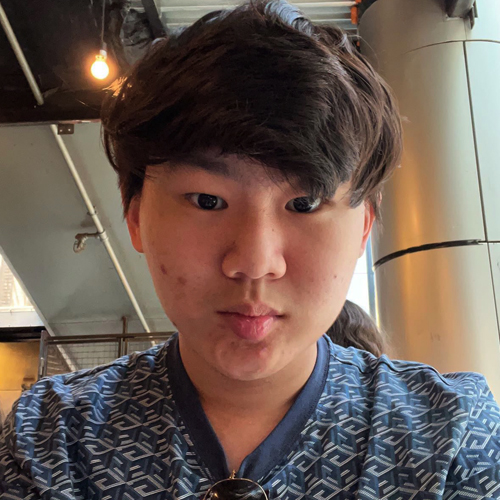
School: Syosset High School, Syosset, NY
Project Title: A Smart Computer Program LauePt4 for Recognizing and Simulating Laue Patterns and Its Applications
Vincent Huang, 17, of Syosset, developed a computer program to address a longstanding obstacle in crystallography for his Regeneron Science Talent Search materials science project: how to easily determine a crystal’s internal atomic structure. A technique called white-beam topography uses X-rays sent through the crystal, which reflects light in a specific pattern, called the Laue pattern, depending on what it is made of (quartz, silicone, etc.). Existing methods for identifying Laue patterns in unknown crystals are time-consuming and expensive, so, using geometric principles, Vincent wrote a computer program that simulates a crystals’ Laue pattern and interior lattice orientation to determine the material. Vincent published this project as first author in the Journal of Applied Crystallography. He believes this work may speed crystal processing and help reduce shortages of computer chips. In addition to captaining the debate team at Syosset High School, Vincent is passionate about Formula One racing, completed a two-month internship at Ferrari leading a team of students in designing an electric “super-car,” and hopes to one day be the technical director of a Formula One team. His parents are Yi Shen and Xianrong Huang.
Howard Ji
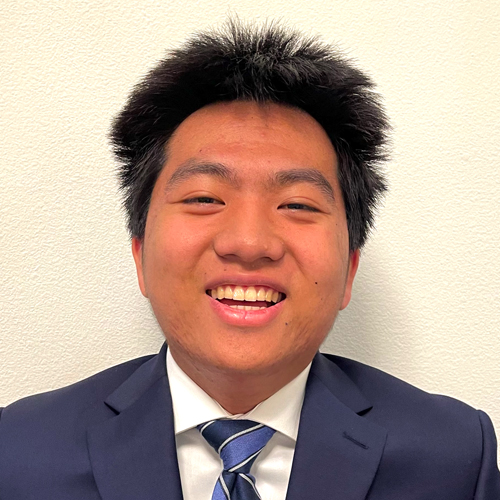
School: University High School, Irvine, CA
Project Title: Development of a Novel Autonomous Column-Climbing Robotic System (AutoBot) for Real-Time Detection and Mapping of Surface Cracks on Bridges
Howard Ji, 17, of Irvine, created a robot to make inspections of aging bridges safer by reducing risks to human inspectors for his Regeneron Science Talent Search engineering project. Howard’s AutoBot has three elements: wire wrapping to hold itself onto the bridge column, hardware that’s responsible for driving and collecting image data, and software that he created to map surface damage in real time. In tests, he deployed four AutoBots wrapped around a bridge’s column and connected by wire, side-by-side, to inspect the surface. Each AutoBot uses two main processors and climbs the column autonomously. In tests on a concrete bridge, the four connected AutoBots climbed together at a speed of 4.7 cm/s while successfully detecting defects at a mean precision rate of about 83%. Howard, the son of Wenhui Zhang and Chuanwen Ji, attends University High School, where he is co-president of the Science Olympiad and science club. Outside the classroom, he co-leads a 10-member team in the American Rocketry Challenge, which involves designing, building, and launching rockets. Howard became a community activist after learning about environmental toxins produced by a nearby asphalt plant.
Amanrai Singh Kahlon
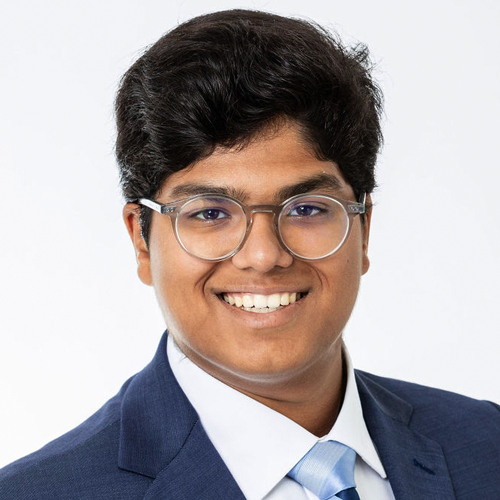
School: Sanford School, Hockessin, DE
Project Title: Enhancing Wearable Gait-Monitoring Systems: Identifying Optimal Kinematic Inputs in Typical Adolescents
Amanrai Singh Kahlon, 17, of Hockessin, utilized specialized sensors that measure motion to investigate how to enhance assistive walking technology with machine learning for his medicine and health Regeneron Science Talent Search project. Precisely identifying someone’s walking gait is crucial to assist walking, but requires expensive, specialized lab equipment. In his project, Rai placed cost-effective, more widely available wearable sensors on the legs of 30 adolescents and identified two signals based on sensor placement that produced consistent, robust data requiring minimal processing. He believes that by producing usable sensor data, these “wearables” can be used to speed the creation of patient-customized exoskeleton assistive devices. Rai plans to conduct future research using data from people with cerebral palsy. He is the lead author of a paper describing this project published in the journal Sensors. The son of Randeep Kahlon and Mona Singh, Rai attends Sanford School where he plays varsity tennis. He is president of Delaware’s first statewide physician-shadowing program and secured a three-year grant to keep program participation cost-free for more than 200 students from 31 high schools.
Gavriela Beatrice Kalish-Schur
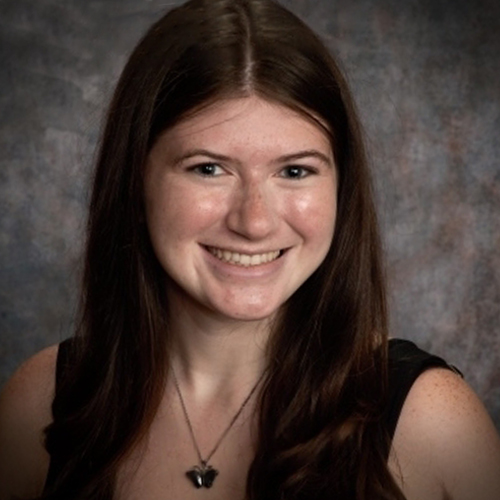
School: Julia R. Masterman High School, Philadelphia, PA
Project Title: IRE1 Knockdown Leads to an Anxiety Phenotype in Drosophila and Changes in BiP and BDNF Levels
Gavriela Beatrice Kalish-Schur, 18, of Philadelphia, studied a potential neurological cause of anxiety using fruit flies as a model, in hopes that one day it may help humans for her Regeneron Science Talent Search neuroscience project. Gavriela focused on a specific brain pathway found in both fruit flies and humans, IRE1, because it affects the critical protective process of cellular protein folding. When folding is disrupted, it can lead to cellular stress, in turn causing anxiety or other problems. She manipulated the fruit flies’ genetics so that the IRE1 pathway was “knocked down” or decreased in different parts of the brain. She noticed that all the flies with the decreased IRE1 spent more time around the outside of the testing dish, indicating anxiety. She also noted various protein levels differed depending on where in the brain the IRE1 was knocked down. She believes these findings suggest multiple research paths to aid in treating anxiety. The daughter of Jennifer Kalish and Yechiel Schur, Gavriela attends Julia R. Masterman High School and edits the newspaper. As president of a social justice group, she received a state award after a voter registration drive enrolled 95% of eligible students at her school. She looks forward to casting her first vote.
Zeyneb N. Kaya
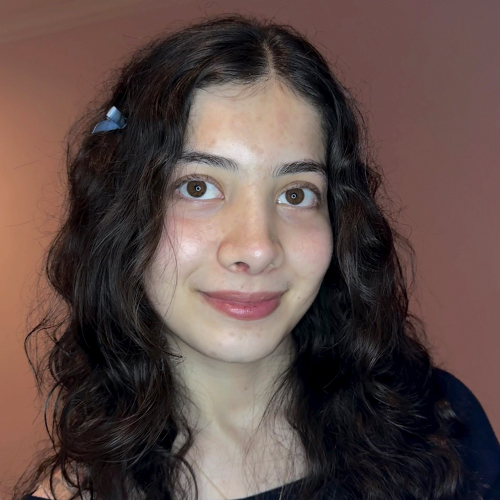
School: Saratoga High School, Saratoga, CA
Project Title: MADLIBS: A Novel Multilingual Data Augmentation Algorithm for Low-Resource Neural Machine Translation
Zeyneb N. Kaya, 17, of Saratoga, improved resources for machine learning models to help preserve endangered languages for her Regeneron Science Talent Search computer science project. Today’s natural language processing (NLP) algorithms, like ChatGPT, work well for languages like English because it has a lot of easily accessible text to learn from. For languages with less accessible text, Zeyneb wrote her own algorithm, called MADLIBS, that generates additional text, which, in turn, allows subsequent NLP algorithms to work better. The key insight was to get more mileage out of the limited existing resources of each language dataset by generating appropriate translation pairs to make grammatically correct sentences and create high-quality translations. Among the endangered languages she investigated was the Māori language from New Zealand. She hopes one day her MADLIBS software will be an open-source resource for people around the world. Zeyneb attends Saratoga High School where she is president of the linguistics club and events coordinator of the Chinese club. The daughter of Latife Genc Kaya and Ahmet Kaya, Zeyneb hopes to pursue a career that combines linguistics and computer science.
Natasha Kulviwat
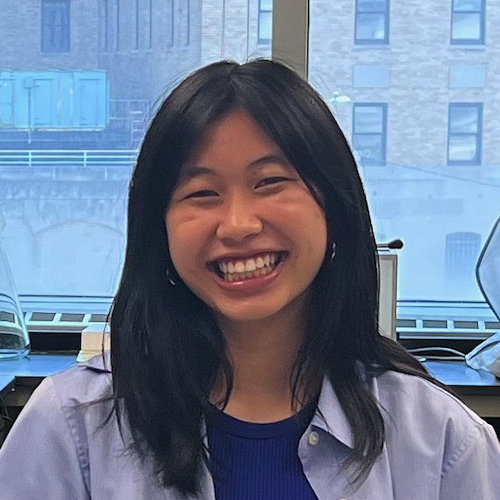
School: Jericho High School, Jericho, NY
Project Title: The Neurobiology of Suicide: Blood-Brain Barrier Breakdown as a Novel Suicide-Risk Biomarker
Natasha Kulviwat, 17, of Jericho, submitted a Regeneron Science Talent Search neuroscience project describing her search for a biomarker to identify people at risk for suicide. In an experimental study, Natasha analyzed de-identified brain tissue, measured levels of claudin-5, albumin, and immunoglobulin G, and found increased amounts of neuroinflammation and claudin-5 in suicide decedents. Analysis of multiple genetic mediators affecting the expression of claudin-5 also revealed that blood-brain-barrier degradation is linked to claudin-5 degradation. Her research suggests that high levels of albumin and the protein claudin-5 may serve as early markers of suicide risk. In May 2023, Natasha received the Gordon E. Moore Award at the Regeneron International Science and Engineering Fair for her earlier research on this subject. Natasha heads the student government at Jericho High School and in her freshman year, started a medical club to engage students in medical research publications. She also founded a nonprofit group promoting free math education to underserved students and has authored two papers in peer-reviewed academic journals. Her parents are Napatsawan Engchanil and Songpol Kulviwat.
Alexis Li
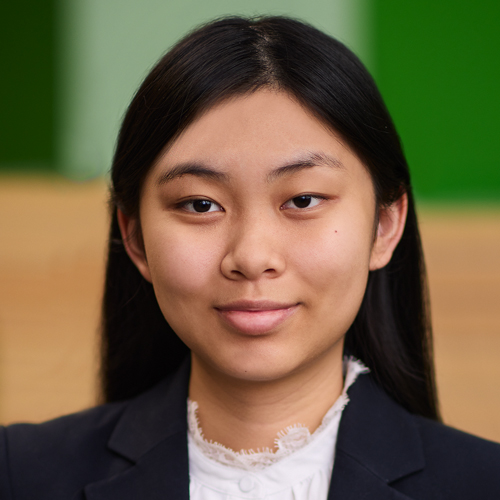
School: Hamilton High School, Chandler, AZ
Project Title: BrainSTEAM: A Practical Pipeline for Connectome-Based fMRI Analysis Toward Brain Disorder Classification
Alexis Li, 17, of Gilbert, developed a suite of machine learning tools that identify key neural patterns in neuropsychiatric conditions for her Regeneron Science Talent Search neuroscience project. Alexis made BrainSTEAM, which analyzes blood flow information in functional MRI images to determine the strength of the connections between regions of the brain, identifying key neural patterns in conditions including autism spectrum disorder, ADHD, and depression. Evaluation against existing tools showed BrainSTEAM outperformed them. Alexis believes her research will help health professionals diagnose these conditions earlier, before it’s too late for treatment, as current diagnoses are typically based on subjective evaluation. Alexis attends Hamilton High School in Chandler, where she captains the Lincoln Douglas debate team, ranking first in the state for all events. A self-described “pickleball addict,” she founded a cross-generational pickleball club composed of high-schoolers and seniors from a local community center. The daughter of Fei Peng and Qiang Li, Alexis wants to pursue her doctorate in bioengineering while running a medical startup that promotes accessible and groundbreaking medical solutions.
Alexandra Mahajan
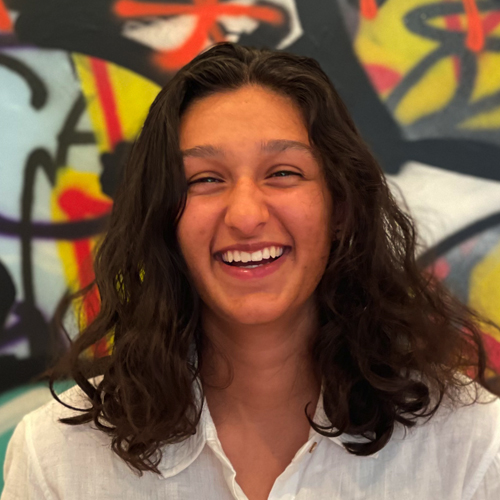
School: Cambridge Rindge & Latin School, Cambridge, MA
Project Title: A Novel Method To Determine Precise Stellar Radii and Temperatures of Low Mass Stars Using JWST Transits and Occultations
Alexandra Mahajan, 17, of Cambridge, developed a new method to measure the radius and temperature of small stars for her Regeneron Science Talent Search space science project. Alexandra chose to study small stars because they are the most promising hosts of habitable planets and are particularly poorly understood. She initially tried to use data from NASA’s TESS telescope, which was designed to search for planets in other solar systems, but found that the TESS telescope was too small to effectively measure small, low-mass stars. She then found and analyzed archived and previously published data from the more powerful James Webb Space Telescope. She modeled this data to determine parameters that best matched the observed data, thereby achieving measurements of the radius and temperature of the low-mass star called GJ 1214 that were much more accurate. Moreover, she found that her approach should allow more precise measurements of many other low-mass stars. The daughter of Satayan Mahajan and Caroline DeStefano, Alexandra attends Cambridge Rindge and Latin School. In her spare time, she writes, records, and produces music, and sells T-shirts that she designed herself to promote ocean conservation.
Ekansh Mittal
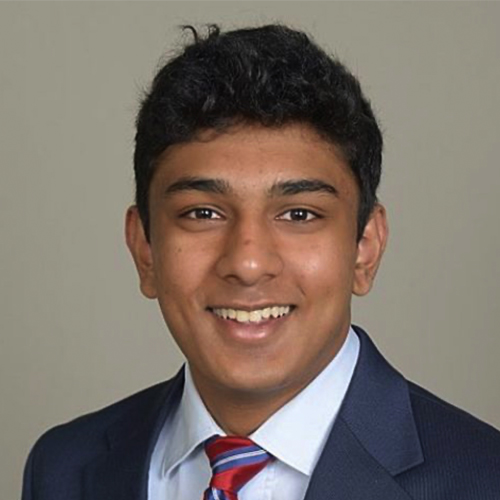
School: Westview High School, Portland, OR
Project Title: Harnessing Machine Learning and 3D Spheroid Cultures To Identify Biomarkers for Combating Drug Resistance in Breast Cancer
Ekansh Mittal, 17, of Beaverton, investigated genes responsible for drug resistance in breast cancer treatments for his Regeneron Science Talent Search cellular and molecular biology project. Using a combination of computational biology and in vitro approaches, Ekansh identified over 30 genes that predicted drug resistance and statistically poor outcomes in breast cancer patients using a machine-learning approach. He focused on one gene, called IGF1R, and its impact on existing cancer treatments and found that inhibiting IGF1R significantly increased the death of cancer cells. He used the recently developed technique of spheroid culture, a 3D cell culture method that mimics tumor cells more accurately than prior 2D methods to validate his results. Ekansh believes that his approach to identifying potential drug resistance genes provides a strong platform to find new targets cancer treatments. Ekansh, the son of Jayesh Mittal and Anupriya Agarwal, attends Westview High School in Portland. He is first author on a paper published in the journal Sensors and founded a nonprofit to prepare students for math and computer science contests. After being delayed by the pandemic he expects to earn his mixed martial arts black belt in 2024.
Ramon Moreno Jr.
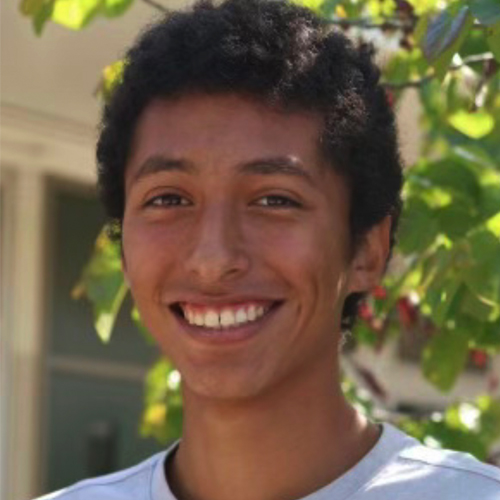
School: Thousand Oaks High School, Thousand Oaks, CA
Project Title: The Influence of Isonicotinamide on the Chronological Lifespan of Saccharomyces cerevisiae Strains
Ramon Moreno, 17, of Thousand Oaks, studied the potential of the chemical compound isonicotinamide (INAM) to extend the lifespan of yeast cells for his Regeneron Science Talent Search biochemistry project. Ramon performed growth and lifespan modification analysis on three different strains of yeast – measuring the effects of different concentrations of INAM on cell growth and on the length of time nondividing cells survive. He found a significant correlation between the influence of INAM and a lack of growth in one strain and between INAM’s influence and the viability of two other strains. He believes his work indicates that the compound is a legitimate candidate for further research and may result in the possible promotion of longevity in certain cells. Ramon attends Thousand Oaks High School where he runs cross country. Inspired by his own immigrant parents, he helped a family of recent immigrants learn to speak, read, and write English, and received recognition from his city. A music lover, Ramon plays flute and violin and taught himself bassoon and keyboard. He is the son of Josephina and Ramon Moreno, and he wants to earn a doctoral degree and become a laboratory researcher specializing in cell studies.
Ella Pilacek
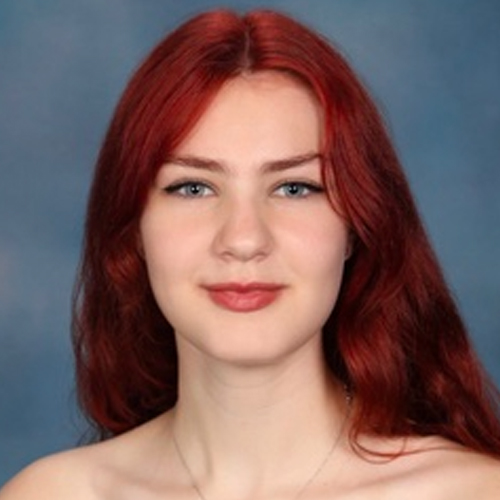
School: Oviedo High School, Oviedo, FL
Project Title: Promoting Attraction of Apis mellifera to the Synthetic Scent of the Endangered Orchid Prosthechea cochleate Using Pavlovian Conditioning and Direct Feeding Paradigms for Conservation
Ella Pilacek, 17, of Winter Springs, researched Pavlovian conditioning of honeybees as a way of promoting pollination of the endangered native orchid Prosthechea cochleata for this Regeneron Science Talent Search animal sciences project. Seeking to address the problem of habitat fragmentation and a lack of native pollinators, Ella investigated how to train non-native honeybees (Apis mellifera) to pollinate the endangered orchid. After testing each of the flower’s volatile organic compounds, Ella used them in a synthetic version of the orchid’s scent, mixed with sucrose as a food reward. After five rounds of conditioned feeding, the experimental group of bees were significantly more attracted to the orchid’s scent, showing the possibility of using synthetic scents to train non-native pollinators to help conserve endangered native plant species. Ella, who is a mentor for fellow student researchers in STEM and a judge in local middle school science fairs, is in the Latin, French and biotechnology clubs at Oviedo High School, and founder of a group to help students succeed in science competitions. Ella, whose parents are Joshua Pilacek, Teresa Pilacek, and Sarah Peat, hopes to pursue a doctorate in biological sciences, studying animal behavior.
Achyuta Rajaram
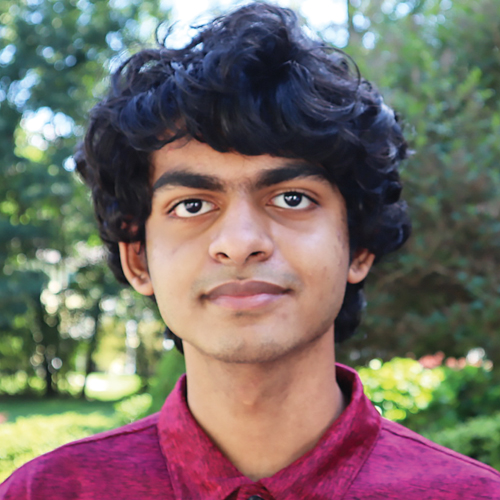
School: Phillips Exeter Academy, Exeter, NH
Project Title: Automatic Discovery of Visual Circuits
Achyuta Rajaram, 17, of Exeter, improved automatic discovery of visual circuits for the computer science project that he submitted to the Regeneron Science Talent Search. In machine learning, computer algorithms find patterns in data to answer important, practical questions. Achyuta’s research improved our ability to discover what computer models, that find patterns in images, are ‘thinking’ when they analyze a photo and which parts of their ‘mechanical brains’ are contributing to the decision making. For example, when a model identifies a car in a photo, does it first identify wheels and use this to identify ‘car-ness,’ or does it look for something else? Achyuta’s key contribution to this effort was to develop an automatic method for recognizing which parts of the algorithms identify what. This knowledge sheds light on what these algorithms are ‘thinking,’ which can help make them more effective, fair, and safe. Achyuta, the son of Nivedita Chevvakula and Rajaram Ramaswamy Kumaraswamy, attends Phillips Exeter Academy, where he is co-head of the physics, chemistry, and chess clubs. His passion for jazz drumming has led him to play in groups ranging from small combos to symphonia orchestra.
Rhea Rastogi
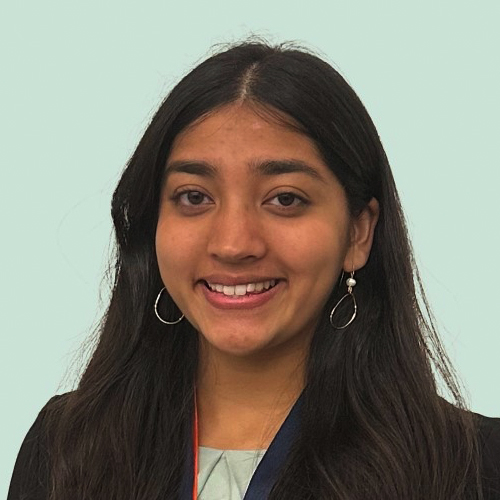
School: Loveless Academic Magnet Program High School, Montgomery, AL
Project Title: Understanding How the Maternal Epigenetic Reprogramming Function of LSD1 Contributes to Inherited Developmental Disease
Rhea Rastogi, 18, of Montgomery, explored whether errors in a type of genetic change known as histone methylation affected future generations for her Regeneron Science Talent Search cellular and molecular biology project. In our cells, DNA is wrapped around proteins called histones; methylation of histones is a mechanism that turns genes on and off. Rhea used the worm model C. elegans and focused on two enzymes, SPR-5 and MET-2, that are controlled by methylation and affect proper gene expression in newly fertilized eggs. Wanting to see if errors in this process affected future generations, Rhea found that offspring of worms missing either enzyme had developmental delays and decreased fertility, effects that accumulated in later generations. With both enzymes missing, offspring had similar problems and severe difficulty detecting food. The mammalian equivalent of SPR-5 is LSD1. In mice with LSD1 mutations, she found phenotypes that paralleled those she noticed in worms. This consistency in both animal models led Rhea to suggest that inappropriate gene regulation during reproduction in the mother can lead to disease. She believes future research may be applied to human conditions, such as Kabuki-like Syndrome. Rhea founded and captains the Speech and Debate team at Loveless Academic Magnet Program High School and competes in the Science Olympiad. Her parents are Nitin and Deepali Rastogi.
Kun-Hyung Roh
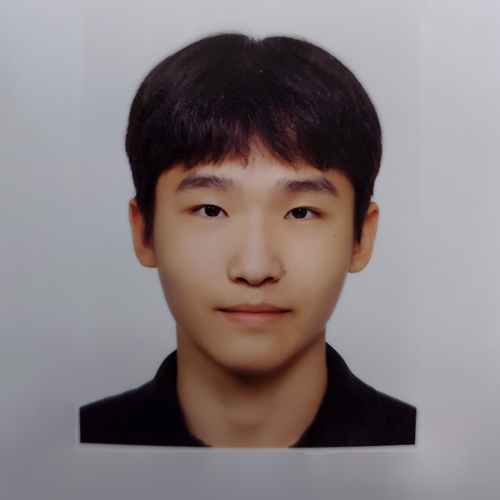
School: Bronx High School of Science, Bronx, NY
Project Title: Novel Drug Discovery Methodology Using Machine Learning for Gene Expression-Based Virtual Screening Predicts Novel Compounds To Reverse Alzheimer’s Disease With Applications to Cancer and Longevity by Inhibiting CtBP2 Expression
Kun-Hyung Roh, 18, of New York, created A.I. software that may ease potential drug discovery by identifying compounds that inhibit gene expression of proteins rather than focusing on the protein structure for his Regeneron Science Talent Search neuroscience project. Kun-Hyung focused on Alzheimer’s disease (AD) and current drug options called phenothiazines, which appear to reduce AD-related brain inflammation. To try to determine how phenothiazines work in the brain, Kun-Hyung developed a machine-learning method that determined the drugs are targeting the expression of a specific gene’s protein whose levels are higher in the brains of AD patients, yet whose structure makes it difficult for the drugs’ small molecules to attach well, reducing their effectiveness. Using his A.I. model, he identified other potential substances that reduce the gene’s expression and lower protein levels. He believes his model may save valuable time in drug discovery for AD. Kun-Hyung founded the machine learning club at the Bronx High School of Science, which established a partnership with a nonprofit to teach free computer science classes to middle schoolers. The son of Yang Soo Kim and Taeho Roh, Kun-Hyung wants to discover new affordable disease treatments.
Linus Tang
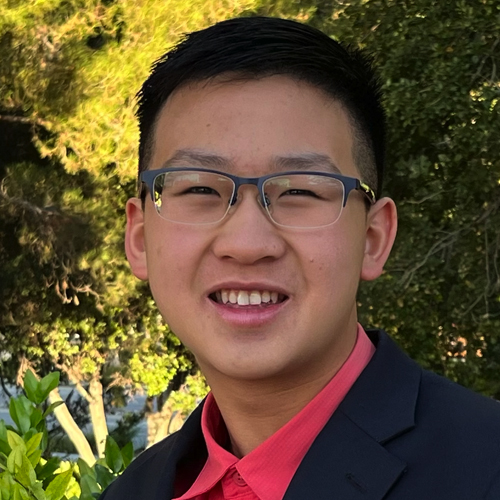
School: Davidson Academy Online, Reno, NV
Project Title: Extremal Bounds on Peripherality Measures
Linus Tang, 17, of San Jose, California, researched peripherality measures in graph theory for his Regeneron Science Talent Search mathematics project. Mathematical networks, made of edges and vertices, are used to model person-to-person interactions to trace disease spread, or to understand systems of chemical interactions, among other applications. A vertex is called central if it is important to the network, such as an influencer in a social network, or a key chemical in a system of reactions. Peripherality is the opposite of centrality. In his work, Linus researched how central and peripheral the vertices in a network can be. He gave bounds on the values that can be achieved by several numerical measures of peripherality. Previous researchers had proven such upper and lower bounds and formed conjectures about the graphs that achieve them. Linus proved tighter upper and lower bounds and refuted two of these conjectures. Linus attends Davidson Academy Online in Reno, Nevada. In 2021, he won first place at the Stanford Math Tournament in the combinatorics round. The son of Seow-Huang Goh and Hsiu-Khuern Tang, Linus spent spring 2022 researching the mathematics behind the game Bulgarian Solitaire.
Riya Tyagi
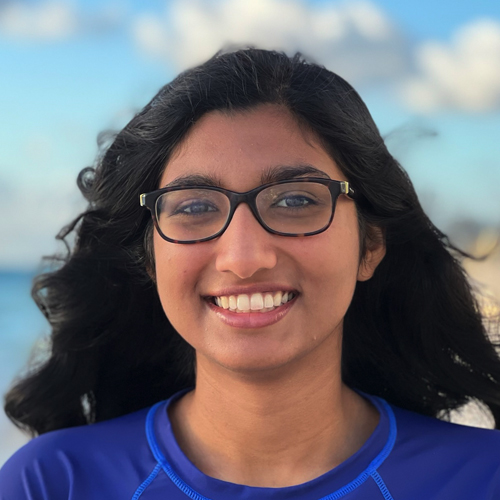
School: Phillips Exeter Academy, Exeter, NH
Project Title: Using Computer Vision To Disentangle Features Enabling AI To Learn Self-Reported Race and Ethnicity From Medical Images
Riya Tyagi, 16, of Exeter, sought to understand how convolutional neural networks have learned how to determine patients’ self-reported race and ethnicity for her Regeneron Science Talent Search computer science project. It currently remains unclear how machine learning, when analyzing medical image data, can determine a patient’s race and ethnicity. Understanding this is key to minimizing bias when A.I. tools are used for medical purposes. By training hundreds of convolutional neural networks, a specific neural network that quickly and precisely analyzes images, Riya investigated what kinds of information the networks were using to determine patients’ race and ethnicity. After the system reviewed 11,000 images of the human retina, Riya determined which key features were responsible. By analyzing these features, she discovered a potential cause of bias: the U-Net segmentation model widely used for medical image processing. She hopes her work will allow development of ethical A.I.-powered healthcare software to minimize racial bias in the future. The daughter of Urvashi and Shishir Tyagi, Riya attends Phillips Exeter Academy, is in Science Olympiad, and co-led her varsity robotics team to a second-place win out of 6,400 teams at a World Championship. She also founded one of the first all-girl Boy Scouts troops and was inducted into the Order of the Arrow.
Grant Wang
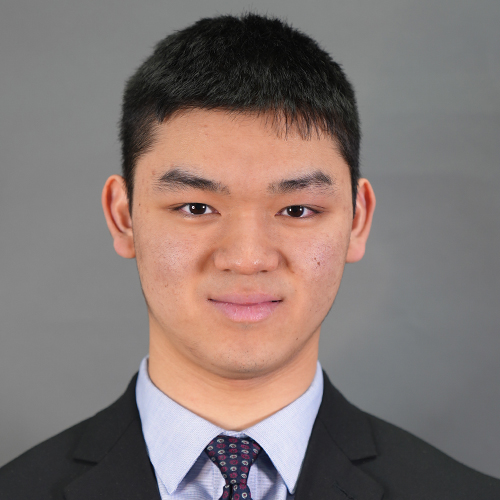
School: Williamsville East High School, East Amherst, NY
Project Title: MLOffense: Multilingual Offensive Language Detection and Target Identification on Social Media Using Graph Attention Transformer
Grant Wang, 17, of East Amherst, created an A.I. model to detect offensive content posted on social media in 100 languages for his Regeneron Science Talent Search behavioral and social sciences project. To develop his software, Grant trained a machine learning tool to understand phrases and sentences in each language and learn what constitutes an offensive sentence. Grant’s software augments other existing tools that currently detect such content, only in English, to detect offensive language in other languages as well. Unlike previous models that focus only on offensive keywords, his model examines the context of the entire sentence so that his system gains a nuanced understanding of the writer’s intent. In addition, it identifies the target of the offensive language, thus becoming a sophisticated evaluator of the post. Grant plays varsity tennis at Williamsville East High School and is a USTA nationally ranked player. He has represented the United States at the International Linguistics Olympiad twice, winning a team silver medal in 2023. The founder of a social justice group, Grant advocates for refugees in ten countries and has made presentations at the United Nations. His parents are Zhiyuan Wang and Lei Ying.
Michelle Wei
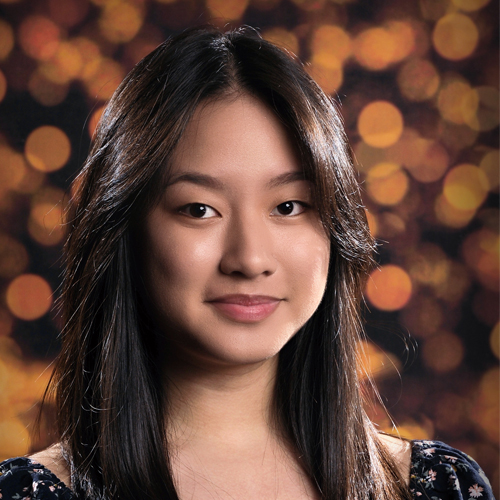
School: The Harker School, San Jose, CA
Project Title: Solving Second-Order Cone Programs Deterministically in Matrix Multiplication Time
Michelle Wei, 17, of Saratoga, improved second-order cone programming (SOCP) solvers for her Regeneron Science Talent Search mathematics project. All of math is about problem solving, but the field of optimization is about how to solve problems quickly. Michelle studied SOCP problems, an important topic in convex programming, a field that helps optimize company supply chains, schedule airline flights, and distribute electrical power. Because these problems are so common and critical, understanding how to solve them more quickly is important — and that’s exactly what Michelle did. In her project, she showed that SOCP problems may always be converted into a modified form that has the same answer but is faster to solve. By solving this modified problem instead of the original, Michelle showed that SOCP problems may be solved more quickly than previously thought. In San Jose, Michelle attends The Harker School. To lower the energy bills of her parents, Raymond Wei and Sharon Wan, Michelle monitored the power consumption of each appliance in the household using only a single pair of sensors to capture both the frequency and time signature of each one. The A.I. model she created analyzed the results.
Nathan Wei
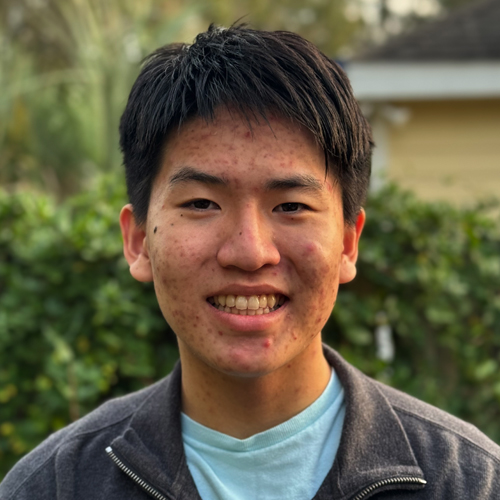
School: Buchholz High School, Gainesville, FL
Project Title: Novel Elastomeric Polystyrene via Photopolymerization and Post-Functionalization of Durable Ultra-High Molecular Weight Perfluorostyrene Copolymers
Nathan Wei, 17, of Gainesville, synthesized an ultra-high molecular weight (UHMW) plastic for his Regeneron Science Talent Search chemistry project. UHMW polymers have the advantage of enhanced strength and durability but are more difficult to produce. However, Nathan demonstrated that a UHMW polymer could be created under blue light with much lower energy requirements by incorporating pentafluorostyrene into the polymer. In addition, by modifying the polymer with dodecanethiol, Nathan produced a version of the polymer that has strong material properties and should also be recyclable. This development could help reduce plastic waste. Nathan believes that his approach should also work with renewable biologically based raw materials, which would make the process even more sustainable. The son of David Wei and Sarah Liu, Nathan is the chapter president of the Future Business Leaders of America and a member of the math and science teams at Buchholz High School. Nathan also volunteers as a museum docent at the Florida Museum of Natural History and as a teacher at a pre-algebra summer camp, and is president of the student association at the Huagen Chinese School.
Julianne Wu
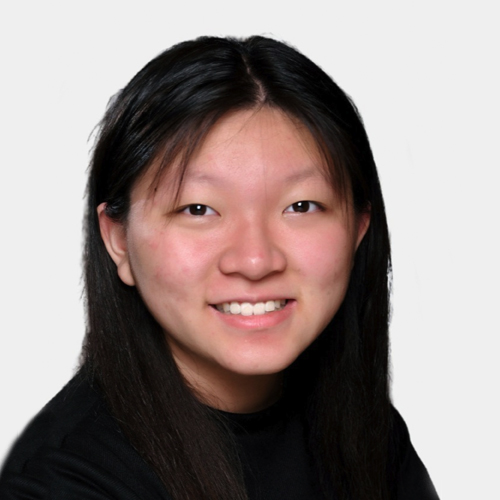
School: University High School, Irvine, CA
Project Title: Sex-Related Signaling of the Angiotensin II Pathway in Primary Aortic Smooth Muscle Cells
Julianne Wu, 17, of Irvine, explored the effects of testosterone and estrogen on arterial tissue to examine how hormones affect the cardiovascular systems of males versus females for her Regeneron Science Talent Search cellular and molecular biology project. Cardiovascular disease is the leading cause of death worldwide and affects males more than pre-menopausal females, but less than post-menopausal females. Julianne studied cell cultures to observe the activity of various chemical receptors when exposed to estrogen, testosterone, or a control substance. She noticed that when male arterial cells were exposed to estrogen, the presence of a protective receptor called angiotensin II type 2 (called AT2) increased. Julianne believes her study will contribute to better understanding the AT2 receptor’s role in mediating the two hormones’ effects on cardiovascular health. A classically trained pianist, Julianne is an integral member of her school’s award-winning Science Bowl team at University High School. She also co-founded a nonprofit dedicated to improving education access for underserved communities. Julianne wants to pursue a career as a physician-scientist, medical journalist, and patient advocate. Her parents are Elizabeth Pan and William Wu.
Selina Zhang
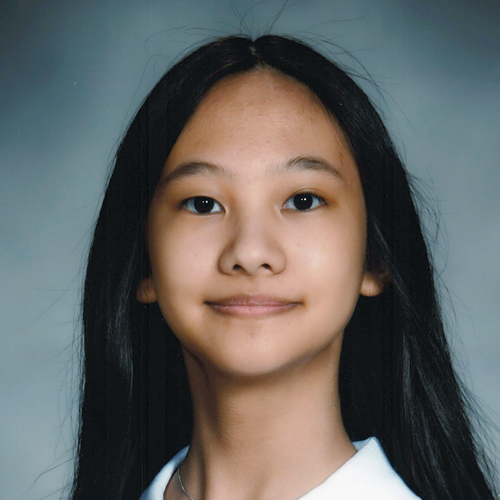
School: North Hunterdon High School, Annandale, NJ
Project Title: ArTreeficial: A Novel AI-Integrated Solution to Reducing Invasive Spotted Lanternfly Populations
Selina Zhang, 18, of Annandale, designed and field tested a synthetic, eco-conscious, A.I.-powered tree that uses machine learning to selectively lure and “zap” the invasive spotted lanternfly (SLF) for her Regeneron Science Talent Search environmental science project. Found in large numbers, with few known predators, SLFs annually cause a tremendous amount of damage to agriculture. Selina’s ArTreeficial tree, made from an umbrella, lures the insects using an incense she made from the SLF’s favorite tree, the tree of heaven, also an invasive species. She used A.I. to first identify the SLF and then energize an electric mesh to kill them. The entire system is solar-powered. Selina’s prototype tree costs just under $200 to construct, but she believes large-scale production could dramatically reduce the cost. She is also researching ways to improve her attractant using an essence from dead SLFs. At North Hunterdon High School, Selina’s passion for STEM opportunities motivated her to bring the USA Biology Olympiad to the school and to found and lead the science bowl and science fair clubs. The daughter of Fan Zhang and Ting Wang, Selina is an award-winning violinist who has performed solo at New York’s Carnegie Hall.
Christopher Zorn
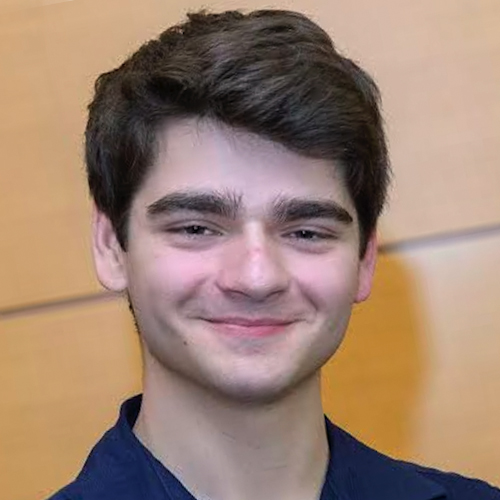
School: Irvington High School, Irvington, NY
Project Title: The Role of MYC in RET Fusion Tumorigenesis and RET Inhibitor Resistance
Christopher Zorn, 17, of Irvington, studied how RET, a gene involved in cellular signals, and the MYC genes, which regulate cell growth and death, affect one another in genetically modified lung cancer cells for his Regeneron Science Talent Search medicine and health project. RET commonly fuses with other genes and leads to many types of tumor development. Christopher created multiple lung cancer cell lines with different RET gene fusion combinations, introduced various chemical agents, and then measured the resulting MYC protein levels. He found the MYC levels were elevated in most of the cell lines, and often led to treatment resistance. He believes his work merits further research on the relationship between RET and MYC, the mechanism that leads to treatment resistance, and potentially targeting RET and MYC together for future treatments. At Irvington High School, Christopher co-founded and is president of the math club. He also helped start a nature clean-up program, now with more than 100 volunteers, to combat an invasive species. The son of James Zorn and Vesselina Traptcheva, Christopher wants to use his bioengineering skills to broaden his research to combat global challenges.
Charisse Zou
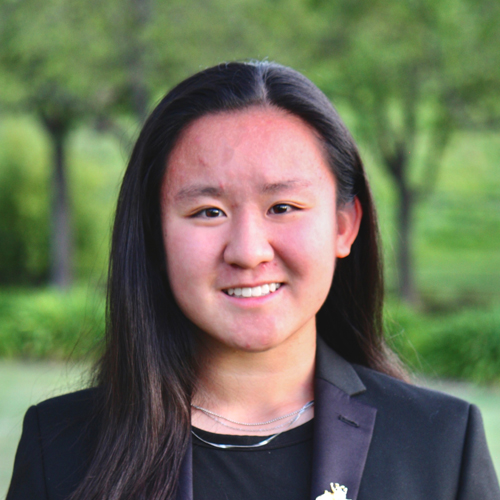
School: Dougherty Valley High School, San Ramon, CA
Project Title: The Development of a Free-Flying Method To Study the Effect of Neonicotinoids on the Positive Transfer of Learning in the Visual Domain of Honeybees
Charisse Zou, 17, of San Ramon, investigated how two commonly used insecticides affected the cognitive abilities of honeybees for her Regeneron Science Talent Search animal sciences project. Charisse conducted her bee experiments using mazes she constructed in her backyard. After observing how the bees reacted to being placed in the maze, she realized that this process stressed the insects and might affect her results, so she designed an experiment in which the bees were trained to fly to and enter the maze on their own. Through her observations of the bees’ behavior, Charisse discovered that exposure to the insecticide imidacloprid reduced the medium-term memory of the bees but not their long- and short-term memory. The effect of a stronger insecticide, clothianidin, was more severe, damaging their long-term memory and likely their short- and medium-term memory as well. Charisse hopes her results will discourage the use of these pesticides. The daughter of Wei Zou and Qi Zeng, Charisse attends Dougherty Valley High School, where she is the vice president of the Science National Honors Society. Charisse also captains a club soccer team, volunteers for the American Red Cross, and plays the flute and piano.
